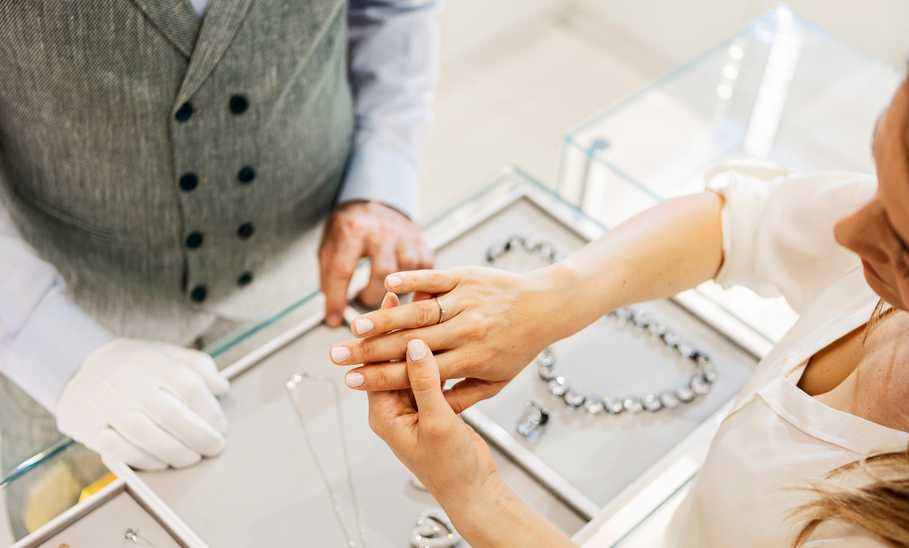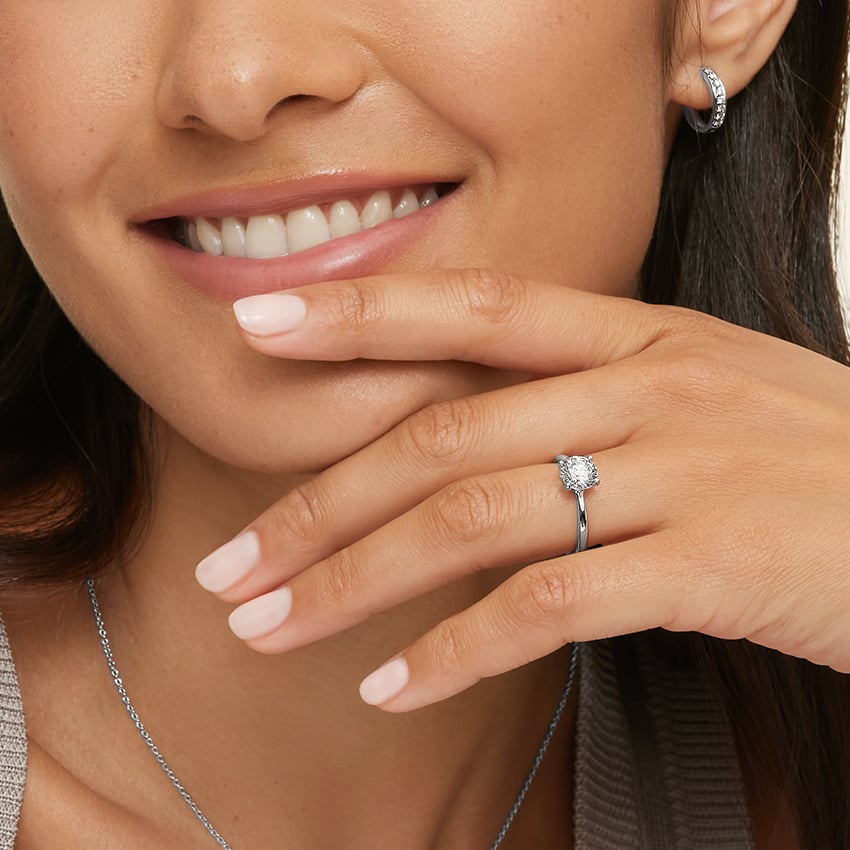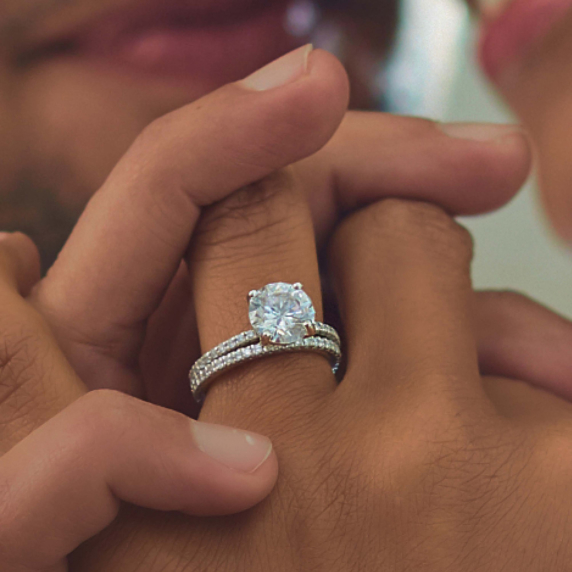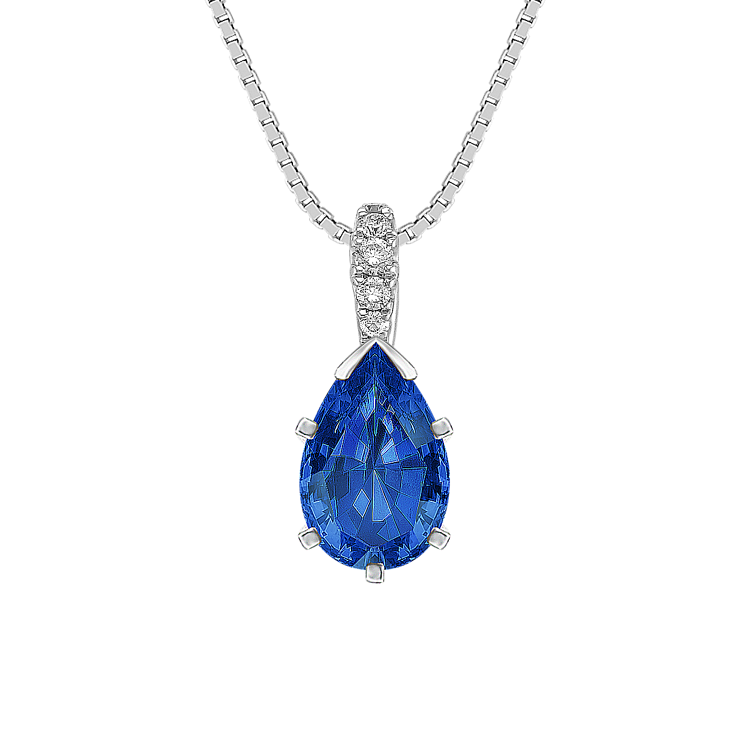The 7 Best Lab-Grown Diamonds to Sparkle, Shine, and Wow

Our evaluations and opinions are not influenced by our advertising relationships, but we may earn a commission from our partners’ links. This content is created by TIME Stamped, under TIME’s direction and produced in accordance with TIME’s editorial guidelines and overseen by TIME’s editorial staff. Learn more about it.
When it comes to choosing an engagement ring, diamonds still remain the most common stone. Indeed, it seems that people still agree that nothing says forever quite like a diamond. Where there has been a shift in recent years, though, is in the purchasing practices of younger consumers, more of whom are choosing lab-grown diamonds over mined diamonds. According to data by jewelry insurance company BriteCo, lab-grown diamonds made up approximately 28.4% of engagement ring sales in 2021—and that figure has been steadily increasing since.
“Lab-grown diamonds (also known as lab created diamonds, man-made diamonds, engineered diamonds, and cultured diamonds) are grown in highly controlled laboratory environments, using advanced technological processes that duplicate the conditions under which diamonds naturally develop when they form in the mantle, beneath the Earth’s crust,” explains Allison Charalambous, VP of Sustainability and Responsible Sourcing at Brilliant Earth, a company that makes and sells lab-grown diamonds.
That is where the differences end, however. “Laboratory-grown diamonds and natural diamonds have essentially the same physical, optical, and chemical properties,” says Sally Magaña, a research scientist and senior manager of identification at the Gemological Institute of America (GIA). “They are both ‘diamonds.’”
Choosing a lab-grown diamond also comes with some additional perks. “Some customers prefer the understanding that no mine was involved, and human rights concerns at the mine are not a factor in this purchase. Others prefer lab grown as they retain the same physical appearance as natural diamonds but can be purchased at a much better price point,” says Charalambous.
Here, discover everything else you need to know about lab-grown diamonds, including our picks for some of the best on the market.
There are few rings more luxurious than a five-stone heirloom. At Vrai, you can get this ring made with five stunning, lab-grown diamonds. After choosing your center diamond, in any shape, size, and quality you like, and your metal, from among white gold, yellow gold, rose gold, and platinum, your center diamond is flanked by 0.7 carats’ worth of four baguette lab-grown diamonds, two 0.25 carats and two 0.1 carats. Another reason we love Vrai: Their diamond foundry is run by hydropower, not fossil fuels, meaning they don’t produce any emissions and are truly an environmentally-friendly option.
Price: Starts around $3,600 for a 1-carat center diamond

If you’re looking for something truly unique and cost-effective, it’s hard to do better than a completely customized ring. The design-your-own option from Grown Brilliance allows you to choose from over 35 ring styles and designs, ranging from classic and luxe to contemporary and three stone. Then you select the setting and metal, and of course the shape, carat, and quality of your lab-grown diamond. If that sounds overwhelming, there are also plenty of pre-set rings to choose from or use as inspiration.
Price: Starts around $800

Make your lab-grown diamond the star with a simple, delicate band like this one from Brilliant Earth. The band is thin, tapering ever so slightly as it approaches the classic four-pronged setting at the top. We also love that it works with any shape diamond you choose, from round or oval to pear or princess, showcasing the diamond all the while. Brilliant Earth has other delicate rings we love as well, including the Petite Elodie and Luxe Viviana.
Price: Starts around $2,000 for the setting and a 1-carat diamond

No matter the look of your engagement ring, it’s hard to go wrong with a wedding band featuring a row of tiny, sparkling diamonds. As such, the Clean Origin Charmant Band is hard to beat. With 30 lab-created diamonds totaling roughly 1/3 of a carat, it looks stunning next to a solitaire or three stone ring, or even a colored diamond or gemstone. Plus, it’s available in white gold, yellow gold, rose gold or platinum. Need we say more?
Price: Starts at $1,215

Just like the perfect bottle of perfume or cologne, the perfect pair of diamond earrings have the ability to say almost as much as the perfect diamond ring. Whether that message is, “I love you,” “I support you,” or, “I cherish you and us”, you’ll convey all of that and more with these lab diamond stud earrings from Ritani. Timeless and sophisticated, you can purchase a pair with guaranteed minimum color and clarity grades. Or you can build your own set the same way you might with a ring, selecting a pair of diamonds in any shape, along with the ideal style and color of the earrings themselves and even the style backing you prefer.
Price: Starts at $285 for 0.25 total carats

A tennis bracelet is a showstopping piece of jewelry. It’s subtle enough to wear every day with just some face cream and foundation, and glamorous enough to wear to the swankiest event with your makeup all done up. If you’re looking for a tennis bracelet filled with gorgeous lab-grown diamonds, look no further than Blue Nile. With options ranging from one to ten total carats, settings in white gold, rose gold, yellow gold, and platinum, different diamond shapes, and even different styles of clasps, you’ll find exactly what you’re looking for.
Price: Starts at $1,650 for 1 total carat

You’ve covered yourself or your loved one with lab-grown diamond rings, earrings, and bracelets…how about a necklace? The beautiful design-your-own pendants at Shane Co. range from simple and classic to utterly stunning. Like many of the other pieces on this list, you start by selecting your lab-grown diamond, then place it in your favorite style pendant, such as infinity, vintage, solitaire or halo. The diamond remains the star throughout, but you can pair it with your preferred chain and setting for a piece that’s perfectly you.
Price: Starts around $1,700 for the setting and a 1-carat diamond

Regardless of whether you’re choosing a lab-grown diamond or a mined diamond, you are going to consider the 4 Cs when making your selection. “The GIA is the creator of the 4 Cs of diamond quality—a globally accepted standard used to assess and describe the characteristics of a diamond,” says Magaña. “Understanding the 4 Cs allows you to evaluate and compare diamonds based on their unique characteristics. By considering the interplay between carat weight, color, clarity, and cut, a consumer can make an informed decision that aligns with their preferences, budget, and desired appearance.” Here’s what you need to know about each.
“Color is graded on a scale from D (colorless) to Z (light yellow or brown),” explains Magaña. The highest quality diamonds are closer to the colorless end of the scale. According to the GIA, most diamonds found in jewelry stores range from colorless to near colorless, or a grade between D and J.
“Clarity measures the presence of internal and external characteristics, known as inclusions and blemishes, within a diamond,” Magaña says. The clarity scale ranges from FL, or Flawless, down to different levels of Included. Most diamonds fall to the lower end of the scale, typically in the VS, or Very Slightly Included, or SL, Slightly Included categories, as diamonds without blemishes are incredibly rare. That said, all blemishes are only visible under 10x magnification, so this is a measurement that is usually not very noticeable to the naked eye.
“Cut refers to how well a diamond has been faceted, which determines its ability to reflect light and scintillation,” says Magaña. Cut is the factor that most influences a diamond’s brilliance and radiance, as it determines how the diamond interacts with light. There are numerous factors that go into a cut quality grade, which ranges from Excellent to Poor.
“Carat Weight is the unit of measurement used to determine the weight of a diamond,” Magaña says. One carat equals 0.2 grams, or about the weight of a paper clip. Diamonds are typically measured to the hundredth of a carat, since even these tiny measurements can affect the total cost of the diamond. According to the GIA, the majority of diamonds used in fine jewelry weigh one carat or less.
“Laboratory-grown diamonds can have 4 Cs grades similar to natural diamonds,” Magaña says. “Many laboratory-grown diamonds are D color, the highest color grade. Laboratory-grown diamonds can also have clarity grades of Flawless and Cut grades of Excellent.”
Indeed, the grading process is exactly the same: Once a lab-grown diamond is ready, it is sent to an independent lab to be certified by an expert and graded based on the 4 Cs. All lab-grown diamonds should come with this report certifying its quality. The report will also state that it is a lab-grown diamond, which is detectable only by experts using special equipment to evaluate the diamonds.
Shopping for lab-grown diamond jewelry is similar to shopping for a good pair of glasses or sunglasses. The first step is to do your research and select a retailer. Look for someone who readily explains the process through which they create their lab-grown diamonds and who supplies either GIA- or IGI-issued quality reports with all of their diamonds. From there, you can use those reports and the information within to select a diamond or diamonds and complete your purchase entirely online.
Alternatively, if you’d like to look at settings and/or compare stones in person, many of the lab-grown diamond retailers here also have physical showrooms around the country, where you can make an appointment to meet with someone who will walk you through your options.
After researching and interviewing lab-grown diamond experts on the qualities to look for regarding this purchase, we then took a similar approach to the consumer who would be shopping for lab-grown diamond jewelry. (Note: I also own a lab-grown diamond ring, so I also considered my own first-hand experience, no pun intended.) We looked for jewelers who supply independently-provided quality reports with all of their lab-grown diamonds. From there, we looked for pieces that awed us with their beauty and quality from retailers with excellent price options, product selection, and customer service.
Yes! They have the same physical and chemical properties as natural mined diamonds. The only difference is that instead of being formed deep in the earth billions of years ago, those conditions are replicated in a laboratory setting to create a new diamond in a matter of weeks.
“A lab grown diamond is grown in a lab, cut, and polished, and sold to a customer. This makes them more cost effective,” explains Charalambous. “A natural diamond, grown within the earth, must be discovered then mined, and the cost to support this discovery is higher and traceability more complicated.”
The quality of lab-grown diamonds does not necessarily depend on who you buy them from. Just like mined diamonds, all lab-grown diamond manufacturers send their diamonds to independent labs to evaluate their quality. That quality measurement is then reflected in the report that accompanies the diamond. As long as the lab-grown diamond you choose comes with one of these reports, and the grades it receives in the 4 Cs are up to your standards, you have a high-quality diamond.
Lab-grown diamonds are graded on the same scale as mined diamonds and can be given equally high grades. Across the board, the highest grades a diamond can receive are a D for color, FL for clarity, and Excellent for cut.
This is a complicated question because it depends on what you consider eco-friendly. Lab-grown diamonds do not require any mining, which has a massive effect on the people, environments, water sources, and ecosystems where it occurs. However, the process of creating diamonds in a lab does use a large amount of energy, and many of the facilities that create diamonds are run on fossil fuels, meaning their carbon footprint is not much smaller than a traditional mining operation.
While the environmental impact is tricky to measure, what is clear is that lab-grown diamonds do eliminate the impact of diamond mining on the places where the mines are located. Plus, adds Charalambous, it’s an innovative approach to a traditional industry. “Millennials, Gen Z, and conscious consumers like to reevaluate how things have always been done and approach it differently,” she says. “Technology has evolved to enable us to recreate the conditions under which a diamond is formed in the earth, instead in a lab. It is a fascinating example of progress and technology.”
The information presented here is created by TIME Stamped and overseen by TIME editorial staff. To learn more, see our About Us page.



